Maurizio Cattelan at the Guggenheim, New York
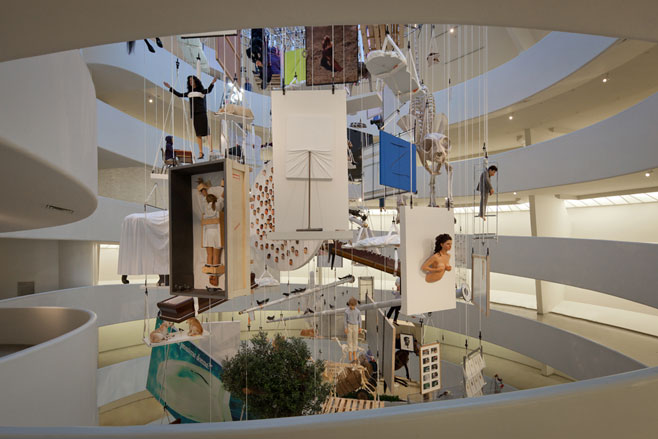
Artist Maurizio Cattelan is a notorious provocateur, best known for controversial sculptures like La Nona Ora (The Ninth Hour) - his effigy of Pope John Paul II pole-axed by a meteorite - and a site specific work in Milan, for which he hung up life-sized models of children by their necks from a tree. The Italian may have just announced his 'retirement', yet he is still up to his old tricks. For 'Maurizio Cattelan: All', his current retrospective at the Guggenheim in New York, Cattelan has strung up his entire oeuvre on a series of ropes, so that it dangles from the museum's rotunda as if hanging from the gallows.
It's a fitting end to a career that seems to have long revolved around death. In fact, before he even became an artist, he worked in a morgue. But mortality aside, the satirist's references are wide ranging, encompassing everything from pop culture and history, to religion - a diversity made all the more apparent in the giant tangled mass in the Guggenheim.
Filling the void of the Frank Lloyd Wright spiral, the 128 works defy chronology, with trademark Cattelan irreverence. As curator Nancy Spector puts it, 'the installation lampoons the idea of comprehensiveness'. There's also a good dose of self-mockery to his act of literal 'career suicide', something that has always pervaded his work. Look closely and among the pieces you'll spot that giant portrait of the artist from 1995, in which he is seen lying on his back, waving his limbs in the air like an eager-to-please dog.
But while 'Maurizio Cattelan: All' is said to be the last show for the Padua-born artist, don't expect him to slip into obscurity any time soon. The exhibition also marks the launch of the fourth issue of Toilet Paper, his ongoing magazine series, produced in collaboration with fashion photographer Pierpaolo Ferrari.
Launched in January 2010 and made up solely of surreal and ambiguous images, Toilet Paper is a direct reference to the disposable nature of publishing. In Cattelan's words: 'Sooner or later all magazines end up in the toilet.' The aesthetic combines high production values with unsettling narratives - often of a violent or sexual nature - and a palpable sense of menace.
Ferrari, who in 2006 created art magazine Le Dictateur, describes the collaboration as a 'mental outburst of shared ideas'. The result is a fascinating collection of visual tableaux that confuse, compel and shock, as well as capturing a kind of edge-of-the-diving-board intensity. Gracing the pages of issue four are everything from a man wearing giant fish heads as shoes, to a female figure covered in clothes pegs.

Watch a short film accompanying the latest issue of Toilet Paper
Receive our daily digest of inspiration, escapism and design stories from around the world direct to your inbox.
In almost every image of Toilet Paper it feels as if something is on the point of happening. But as with everything Cattelan touches, you never know quite what. And, in spite of his deathly stunt at the Guggenheim, it serves as a potent reminder that you shouldn't write his epitaph just yet.
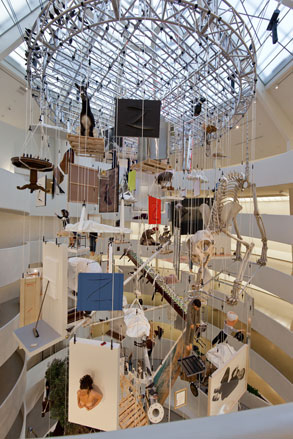
Nearly 130 of his works fill the Frank Lloyd Wright spiral; Courtesy of the Solomon R. Guggenheim Foundation

Among the works on show is 'La Rivoluzione siamo noi' from 2000
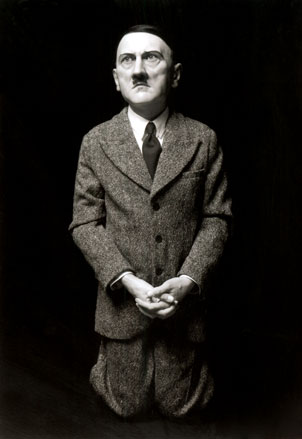
'Him' by Maurizio Cattelan, 2001; Courtesy of the artist

'Mini Me' by Maurizio Cattelan, 1999; Courtesy of the artist

'L.O.V.E.' by Maurizio Cattelan, 2010
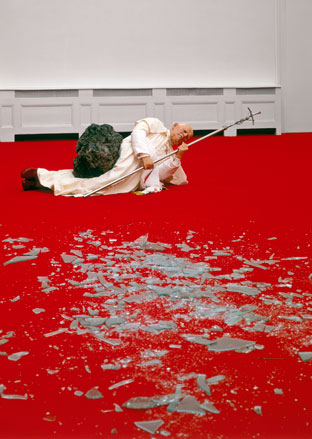
'La Nona Ora' by Maurizio Cattelan, 1999; Courtesy of the artist
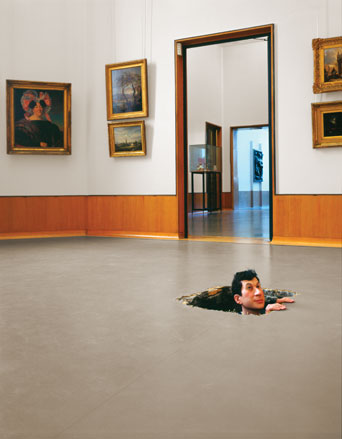
'Untitled' by Maurizio Cattelan, 2001; Courtesy of the artist
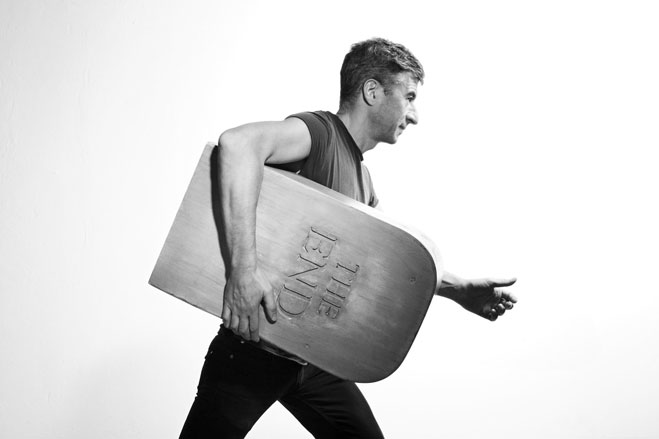
Maurizio Cattelan
-
 Terrified to get inked? This inviting Brooklyn tattoo parlour is for people who are 'a little bit nervous'
Terrified to get inked? This inviting Brooklyn tattoo parlour is for people who are 'a little bit nervous'With minty-green walls and an option to 'call mom', Tiny Zaps' Williamsburg location was designed to tame jitters
-
 Let’s hear it for the Chopard L.U.C Grand Strike chiming watch
Let’s hear it for the Chopard L.U.C Grand Strike chiming watchThe Swiss watchmaker’s most complicated timepiece to date features an innovative approach to producing a crystal-clear sound
-
 Form... and flavour? The best design-led restaurant debuts of 2025
Form... and flavour? The best design-led restaurant debuts of 2025A Wallpaper* edit of the restaurant interiors that shaped how we ate, gathered and lingered this year
-
 Out of office: The Wallpaper* editors’ picks of the week
Out of office: The Wallpaper* editors’ picks of the week'Tis the season for eating and drinking, and the Wallpaper* team embraced it wholeheartedly this week. Elsewhere: the best spot in Milan for clothing repairs and outdoor swimming in December
-
 Nadia Lee Cohen distils a distant American memory into an unflinching new photo book
Nadia Lee Cohen distils a distant American memory into an unflinching new photo book‘Holy Ohio’ documents the British photographer and filmmaker’s personal journey as she reconnects with distant family and her earliest American memories
-
 Out of office: The Wallpaper* editors’ picks of the week
Out of office: The Wallpaper* editors’ picks of the weekIt’s been a week of escapism: daydreams of Ghana sparked by lively local projects, glimpses of Tokyo on nostalgic film rolls, and a charming foray into the heart of Christmas as the festive season kicks off in earnest
-
 Ed Ruscha’s foray into chocolate is sweet, smart and very American
Ed Ruscha’s foray into chocolate is sweet, smart and very AmericanArt and chocolate combine deliciously in ‘Made in California’, a project from the artist with andSons Chocolatiers
-
 Inside the work of photographer Seydou Keïta, who captured portraits across West Africa
Inside the work of photographer Seydou Keïta, who captured portraits across West Africa‘Seydou Keïta: A Tactile Lens’, an exhibition at the Brooklyn Museum, New York, celebrates the 20th-century photographer
-
 Out of office: The Wallpaper* editors’ picks of the week
Out of office: The Wallpaper* editors’ picks of the weekFrom sumo wrestling to Singaporean fare, medieval manuscripts to magnetic exhibitions, the Wallpaper* team have traversed the length and breadth of culture in the capital this week
-
 María Berrío creates fantastical worlds from Japanese-paper collages in New York
María Berrío creates fantastical worlds from Japanese-paper collages in New YorkNew York-based Colombian artist María Berrío explores a love of folklore and myth in delicate and colourful works on paper
-
 Out of office: the Wallpaper* editors’ picks of the week
Out of office: the Wallpaper* editors’ picks of the weekAs we approach Frieze, our editors have been trawling the capital's galleries. Elsewhere: a 'Wineglass' marathon, a must-see film, and a visit to a science museum